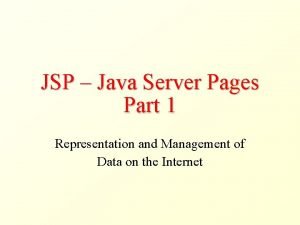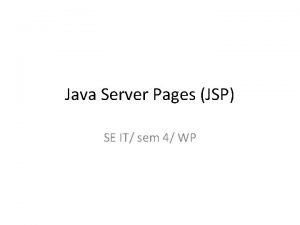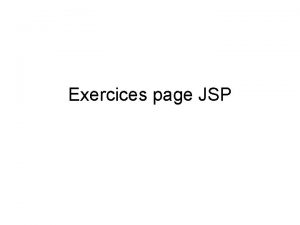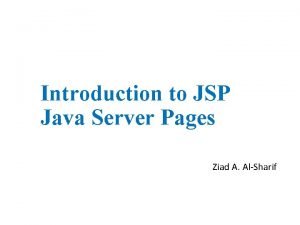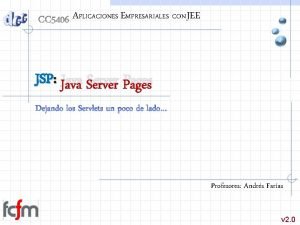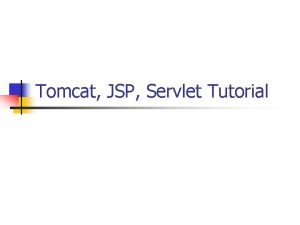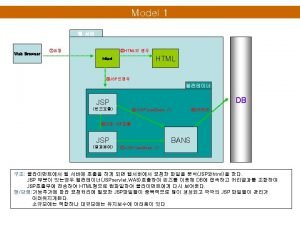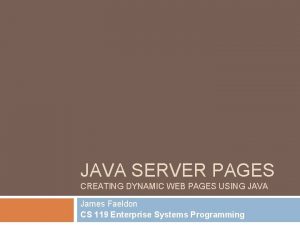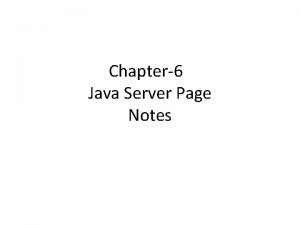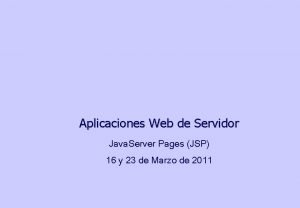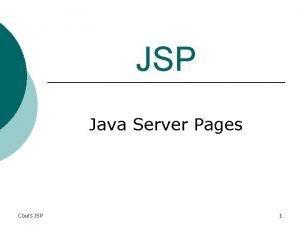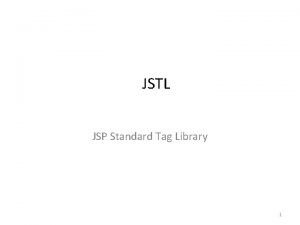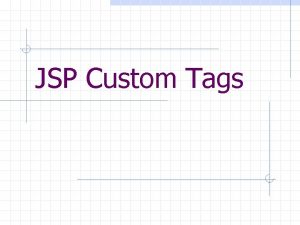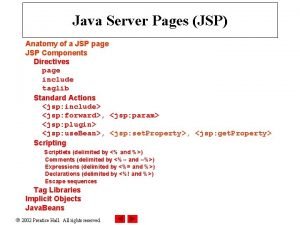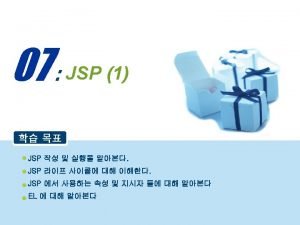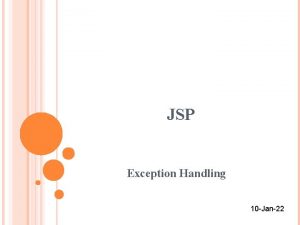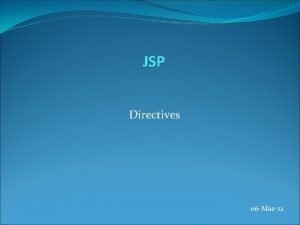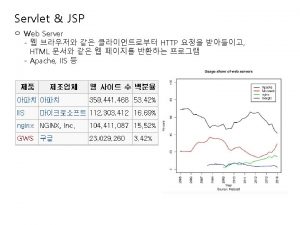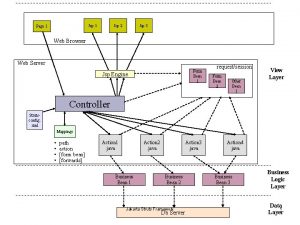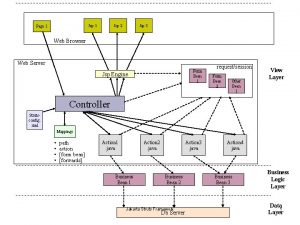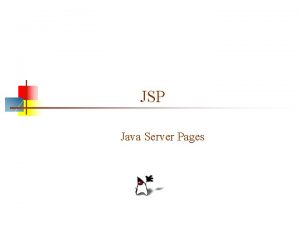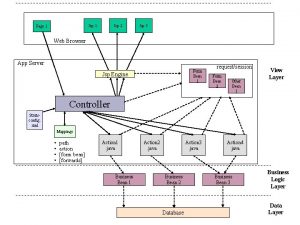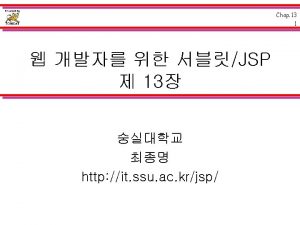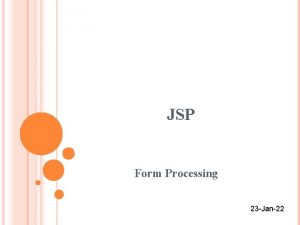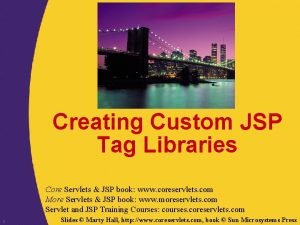JSP Actions 08 Jan22 JSP Actions JSP actions





























- Slides: 29

JSP Actions 08 -Jan-22

JSP Actions JSP actions use constructs in XML syntax to control the behavior of the servlet engine. You can dynamically insert a file, reuse Java. Beans components, forward the user to another page, or generate HTML for the Java plugin. There is only one syntax for the Action element, as it conforms to the XML standard: <jsp: action_name attribute="value" /> Actions are XML-syntax tags used to control the servlet engine Examples <jsp: include page="URL " flush="true" /> Inserts the indicated relative URL at execution time (not at compile time, like the include directive does) This is great for rapidly changing data <jsp: forward page="URL" /> <jsp: forward page="<%= Java. Expression %>" /> Jump to the (static) URL or the (dynamically computed) Java. Expression resulting in a URL

Action Elements Standard Actions Custom Actions JSTL (tag library) Actions 3

Standard Actions <jsp: use. Bean> Makes a Java. Beans component available in a page <jsp: get. Property> Gets a property value from a Java. Beans component and adds it to the response <jsp: set. Property> Set a Java. Beans property value <jsp: include> Includes the response from a servlet or JSP page during the request processing phase 4

Standard Actions <jsp: forward> Forwards the processing of a request to servlet or JSP page <jsp: param> Adds a parameter value to a request handed off to another servlet or JSP page using <jsp: include> or <jsp: forward> <jsp: plugin> Generates HTML that contains the appropriate client browser-dependent elements (OBJECT or EMBED) needed to execute an applet with the Java Plug-in software 5

Custom Actions (Tag Libraries) Can Define Your own! Description Define Install Declare Use 6

JSTL Tags <%@ taglib prefix="c" uri="http: //java. sun. com/jstl/core" %>. . . <c: out value="${1 + 2 + 3}" /> 7

JSP Standard Tag Library Built on custom tag infrastructure <%@ page content. Type="text/html" %> <%@ taglib prefix="c" uri="http: //java. sun. com/jstl/core" %> <html> <head> <title>JSP is Easy</title> </head> <body bgcolor="white"> <h 1>JSP is as easy as. . . </h 1> 1 + 2 + 3 = <c: out value="${1 + 2 + 3}" /> </body> </html> 8

JSTL Control Tags <%@ page content. Type="text/html" %> <%@ taglib prefix="c “uri="http: //java. sun. com/jstl/core" %> <c: if test="${2>0}"> It's true that (2>0)! </c: if> <c: for. Each items="${param. Values. food}" var="current"> <c: out value="${current}" /> </c: for. Each> Note : We’ll learn more about Custom Actions and JSTL Actions in separate sessions 9

Standard Action Elements: Action elements are basically predefined functions and there are following JSP actions available: Syntax Purpose jsp: include Includes a file at the time the page is requested jsp: use. Bean Finds or instantiates a Java. Bean jsp: set. Property Sets the property of a Java. Bean jsp: get. Property Inserts the property of a Java. Bean into the output jsp: forward Forwards the requester to a new page jsp: plugin Generates browser-specific code that makes an OBJECT or EMBED tag for the Java plugin jsp: element Defines XML elements dynamically. jsp: attribute Defines dynamically defined XML element's attribute. jsp: body Defines dynamically defined XML element's body. jsp: text Use to write template text in JSP pages and documents.

Common Attributes: There are two attributes that are common to all Action elements: the id attribute and the scope attribute. Id attribute: The id attribute uniquely identifies the Action element, and allows the action to be referenced inside the JSP page. If the Action creates an instance of an object the id value can be used to reference it through the implicit object Page. Context Scope attribute: This attribute identifies the lifecycle of the Action element. The id attribute and the scope attribute are directly related, as the scope attribute determines the lifespan of the object associated with the id. The scope attribute has four possible values: (a) page, (b)request, (c)session, and (d) application.

The <jsp: include> Action This action lets you insert files into the page being generated. The syntax looks like this: <jsp: include page="relative URL" flush="true" /> Unlike the include directive, which inserts the file at the time the JSP page is translated into a servlet, this action inserts the file at the time the page is requested. Following is the list of attributes associated with include action: Attribute Description page The relative URL of the page to be included. flush The boolean attribute determines whether the included resource has its buffer flushed before it is included. Include Files at Request Time <jsp: include page="news/Item 1. html"/> page attribute must point to a page that is HTML or a page that produces HTML (via JSP, CGI, etc). . . 12

<jsp: include> Example Let us define following two files (a)date. jps and (b) main. jsp as follows: Following is the content of date. jsp file: <p> Today's date: <%= (new java. util. Date()). to. Locale. String()%> </p> Here is the content of main. jsp file: <html> <head> <title>The include Action Example</title> </head> <body> <center> <h 2>The include action Example</h 2> <jsp: include page="date. jsp" flush="true" /> </center> </body> </html> 13

<jsp: include> Example…contd Now let us keep all these files in root directory and try to access main. jsp. This would display result something like this: The include action Example Today's date: 12 -Sep-2010 14: 54: 22 14

The <jsp: use. Bean> Action The use. Bean action is quite versatile. It first searches for an existing object utilizing the id and scope variables. If an object is not found, it then tries to create the specified object. The simplest way to load a bean is as follows: <jsp: use. Bean id="name" class="package. class" /> Once a bean class is loaded, you can use jsp: set. Property and jsp: get. Property actions to modify and retrieve bean properties. Following is the list of attributes associated with use. Bean action: Attribute Description class Designates the full package name of the bean. type Specifies the type of the variable that will refer to the object. bean. Name Gives the name of the bean as specified by the instantiate () method of the java. beans. Beans class. Let us discuss about jsp: set. Property and jsp: get. Property actions before giving a valid example related to these actions. 15

The <jsp: set. Property> Action The set. Property action sets the properties of a Bean. The Bean must have been previously defined before this action. There are two basic ways to use the set. Property action: You can use jsp: set. Property after, but outside of, a jsp: use. Bean element, as below: <jsp: use. Bean id="my. Name". . . />. . . <jsp: set. Property name="my. Name" property="some. Property". . . /> In this case, the jsp: set. Property is executed regardless of whether a new bean was instantiated or an existing bean was found. A second context in which jsp: set. Property can appear is inside the body of a jsp: use. Bean element, as below: <jsp: use. Bean id="my. Name". . . >. . . <jsp: set. Property name="my. Name" property="some. Property". . . /> </jsp: use. Bean> 16 Here, the jsp: set. Property is executed only if a new object was instantiated, not if an existing one was found.

Following is the list of attributes associated with set. Property action: Attribute Description name Designates the bean whose property will be set. The Bean must have been previously defined. property Indicates the property you want to set. A value of "*" means that all request parameters whose names match bean property names will be passed to the appropriate setter methods. value The value that is to be assigned to the given property. The the parameter's value is null, or the parameter does not exist, the set. Property action is ignored. param The param attribute is the name of the request parameter whose value the property is to receive. You can't use both value and param, but it is permissible to use neither.

The <jsp: get. Property> Action The get. Property action is used to retrieve the value of a given property and converts it to a string, and finally inserts it into the output. The get. Property action has only two attributes, both of which are required ans simple syntax is as follows: <jsp: use. Bean id="my. Name". . . />. . . <jsp: get. Property name="my. Name" property="some. Property". . . /> Following is the list of required attributes associated with set. Property action: Attribute 18 Description name The name of the Bean that has a property to be retrieved. The Bean must have been previously defined. property The property attribute is the name of the Bean property to be retrieved.

<jsp: get. Property> Example Let us define a test bean which we will use in our example: /* File: Test. Bean. java */ package action; public class Test. Bean { private String message = "No message specified"; public String get. Message() { return(message); } public void set. Message(String message) { this. message = message; } } Compile above code to generate Test. Bean. class file and make sure that you copied Test. Bean. class in C: _tomcat-5. 5webappsWEB-INFclassesaction folder and CLASSPATH variable should also be set to this folder: Now use the following code in main. jsp file which loads the bean and sets/gets a simple 19 String parameter:

Example…contd <html> <head> <title>Using Java. Beans in JSP</title> </head> <body> <center> <h 2>Using Java. Beans in JSP</h 2> <jsp: use. Bean id="test" class="action. Test. Bean" /> <jsp: set. Property name="test" property="message" value="Hello JSP. . . " /> <p>Got message. . </p> <jsp: get. Property name="test" property="message" /> </center> </body> </html> 20

Example…contd Now try to access main. jsp, it would display following result: Using Java. Beans in JSP Got message. . Hello JSP. . . 21

The <jsp: forward> Action The forward action terminates the action of the current page and forwards the request to another resource such as a static page, another JSP page, or a Java Servlet. The simple syntax of this action is as follows: <jsp: forward page="Relative URL" /> Following is the list of required attributes associated with forward action: Attribute page Description Should consist of a relative URL of another resource such as a static page, another JSP page, or a Java Servlet. Example: Let us reuse following two files (a) date. jsp and (b) main. jsp as follows: Following is the content of date. jsp file: 22

Example <p> Today's date: <%= (new java. util. Date()). to. Locale. String()%> </p> Here is the content of main. jsp file: <html><head> <title>The include Action Example</title> </head> <body> <center><h 2>The include action Example</h 2> <jsp: forward page="date. jsp" /></center> </body></html> Now let us keep all these files in root directory and try to access main. jsp. This would display result something like as below. Here it discarded content from main page and displayed content from forwarded page only. Today's date: 12 -Sep-2010 14: 54: 22 23

The <jsp: plugin> Action The plugin action is used to insert Java components into a JSP page. It determines the type of browser and inserts the <object> or <embed> tags as needed. If the needed plugin is not present, it downloads the plugin and then executes the Java component. The Java component can be either an Applet or a Java. Bean. The plugin action has several attributes that correspond to common HTML tags used to format Java components. The <param> element can also be used to send parameters to the Applet or Bean. Following is the typical syntax of using plugin action: <jsp: plugin type="applet" codebase="dirname" code=" My. Applet. class” width="60" height="80"> <jsp: param name="fontcolor" value="red" /> <jsp: param name="background" value="black" /> <jsp: fallback> Unable to initialize Java Plugin </jsp: fallback> </jsp: plugin> You can try this action using some applet if you are interested. A new element, the <fallback> element, can be used to specify an error string to be sent to the user in case the component 24 fails.

The <jsp: element> Action The <jsp: attribute> Action The <jsp: body> Action The <jsp: element>, lt; jsp: attribute> and <jsp: body> actions are used to define XML elements dynamically. The word dynamically is important, because it means that the XML elements can be generated at request time rather than statically at compile time. Following is a simple example to define XML elements dynamically: <%@page language="java" content. Type="text/html"%> <html xmlns="http: //www. w 3 c. org/1999/xhtml" xmlns: jsp="http: //java. sun. com/JSP/Page"> <head> <title>Generate XML Element</title> </head> <body> <jsp: element name="xml. Element"> <jsp: attribute name="xml. Element. Attr"> Value for the attribute </jsp: attribute> <jsp: body> Body for XML element </jsp: body> </jsp: element> </body> </html>

This would produce following HTML code at run time: <html xmlns="http: //www. w 3 c. org/1999/xhtml" xmlns: jsp="http: //java. sun. com/JSP/Page"> <head> <title>Generate XML Element </title> </head> <body> <xml. Element. Attr="Value for the attribute"> Body for XML element </xml. Element> </body> </html>

The <jsp: text> Action The <jsp: text> action can be used to write template text in JSP pages and documents. Following is the simple syntax for this action: <jsp: text>Template data</jsp: text> The body fo the template cannot contain other elements; it can only contain text and EL expressions ( Note: EL expressions are explained in subsequent chapter). Note that in XML files, you cannot use expressions such as ${whatever > 0}, because the greater than signs are illegal. Instead, use the gt form, such as ${whatever gt 0} or an alternative is to embed the value in a CDATA section. <jsp: text><![CDATA[ ]]></jsp: text> 27

The <jsp: text> Action If you need to include a DOCTYPE declaration, for instance for XHTML, you must also use the <jsp: text> element as follows: <jsp: text><![CDATA[<!DOCTYPE html. PUBLIC "-//W 3 C//DTD XHTML 1. 0 Strict//EN""DTD/xhtml 1 -strict. dtd">]]> </jsp: text> <head> <title>jsp: textaction</title> </head> <body> <books> <book><jsp: text> Welcome to JSP Programming </jsp: text></books> </body> </html> Try above example with and without <jsp: text> action. 28

THANK YOU…
 Bean jsp
Bean jsp Jsp 구구단
Jsp 구구단 Thymeleaf rowspan
Thymeleaf rowspan Define jsp
Define jsp Jsp database access
Jsp database access Jsp engine
Jsp engine What is jsp
What is jsp Exercice 1 page
Exercice 1 page Jsp 539
Jsp 539 Jsp vs servlet
Jsp vs servlet Java jsp
Java jsp Tomcat java servlet tutorial
Tomcat java servlet tutorial Jsp539
Jsp539 Html에서 jsp include
Html에서 jsp include Payroll card
Payroll card Servlet
Servlet Scriplets
Scriplets Jsp architecture diagram
Jsp architecture diagram Plan oral brevet
Plan oral brevet Jsp overview
Jsp overview Comentarios en jsp
Comentarios en jsp Commentaire jsp
Commentaire jsp Mvc architecture in jsp
Mvc architecture in jsp Mineresepter.no/mineresepter/velkommen.jsp
Mineresepter.no/mineresepter/velkommen.jsp Jsp standard tag library
Jsp standard tag library Climatic injury
Climatic injury What is jsp
What is jsp Custom tags in jsp
Custom tags in jsp Anatomy of a jsp page
Anatomy of a jsp page Java jsp
Java jsp



